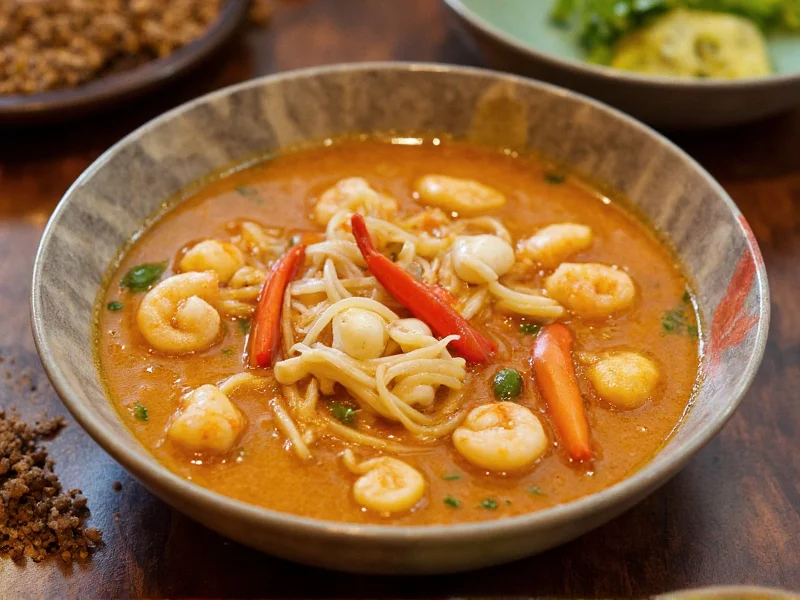When preparing shrimp noodle soup, the quality of ingredients directly impacts the final dish. Fresh shrimp provides superior texture and flavor compared to frozen alternatives, though properly thawed frozen shrimp works well too. The broth forms the foundation—whether using homemade stock or carefully selected store-bought options, a clear, well-balanced broth enhances rather than overwhelms the delicate shrimp flavor.
The Cultural Journey of Shrimp Noodle Soup
Shrimp noodle soup traces its origins to coastal regions across Southeast Asia where fresh seafood was abundant. In China's Fujian province, seafood noodle soups date back centuries, featuring delicate broth and thin wheat noodles. Vietnamese miêu thit incorporates shrimp with pork and chicken broth, while Thai khanom jeen nam ngiao features rice noodles in a spicy shrimp-based broth.
These regional variations demonstrate how local ingredients and cultural preferences shaped distinct interpretations of shrimp noodle soup. Chinese versions often emphasize clarity of broth with minimal seasoning, Vietnamese iterations balance sweet and savory elements, and Thai preparations incorporate bold spices and herbs for complex flavor profiles.
Essential Ingredients for Authentic Shrimp Noodle Soup
Creating exceptional shrimp noodle soup requires attention to three critical components: the broth, the noodles, and the shrimp preparation.
| Component | Recommended Options | Preparation Tips |
|---|---|---|
| Broth | Homemade shrimp shell stock, light chicken broth, or vegetable broth | Simmer shrimp shells with ginger for 20 minutes for maximum flavor extraction |
| Noodles | Rice noodles, egg noodles, or wheat udon | Cook noodles separately and add just before serving to prevent mushiness |
| Shrimp | Medium to large shrimp (31/40 count), peeled with tails on | Marinate briefly in cornstarch and rice wine for improved texture |
Step-by-Step Preparation Guide for Homemade Shrimp Noodle Soup
Follow these professional techniques to create restaurant-quality shrimp noodle soup at home:
- Prepare the broth foundation: Simmer shrimp shells with 1-inch ginger slices, 2 green onions, and 4 cups water for 20 minutes. Strain thoroughly to remove all shell fragments.
- Enhance flavor depth: Return clear broth to heat, adding 1 tablespoon fish sauce, 1 teaspoon sugar, and a pinch of white pepper. Avoid salt initially as shrimp naturally contain sodium.
- Prepare shrimp properly: Toss peeled shrimp with 1 teaspoon cornstarch and 1 tablespoon rice wine. Let sit 10 minutes before cooking to improve texture and flavor absorption.
- Cook noodles separately: Prepare noodles according to package directions but undercook by 1 minute. Rinse under cold water to stop cooking and prevent sticking.
- Final assembly: Bring broth to gentle simmer, add shrimp and cook 2-3 minutes until just opaque. Add pre-cooked noodles and heat through without boiling.
Regional Variations Worth Exploring
Understanding regional differences helps customize your shrimp noodle soup experience:
- Chinese-style shrimp noodle soup: Features clear broth with minimal seasoning, wheat noodles, and delicate shrimp preparation. Often includes bok choy and wood ear mushrooms for texture contrast.
- Vietnamese shrimp noodle soup (Miêu Thit): Incorporates both shrimp and pork broth, with rice noodles, fresh herbs, and a side of nuoc mam for personalized seasoning.
- Thai coconut shrimp noodle soup: Uses coconut milk for richness, with lemongrass, kaffir lime leaves, and galangal creating distinctive aromatic profile. Often includes chili for heat.
- Singaporean shrimp laksa: Combines shrimp broth with spicy curry paste, tamarind, and coconut milk for a complex, flavorful soup with rice vermicelli.
Avoiding Common Shrimp Noodle Soup Mistakes
Even experienced cooks make these frequent errors when preparing shrimp noodle soup:
- Overcooking shrimp: Shrimp cooks in 2-3 minutes in simmering broth. Remove immediately when opaque to maintain tender texture.
- Boiling the finished soup: Vigorous boiling after adding shrimp makes the protein tough and can cloud the broth.
- Adding noodles too early: Noodles continue cooking in hot broth, becoming mushy if added before serving.
- Using low-quality broth: Weak broth gets overwhelmed by other flavors. Concentrate flavors by reducing store-bought broth by 25% before use.
- Over-seasoning: Shrimp has natural sweetness that balances well with subtle seasoning. Add salt incrementally and taste frequently.
Storage and Reheating Guidelines
Proper storage maintains quality when enjoying shrimp noodle soup across multiple meals:
- Store components separately: broth, cooked noodles, and cooked shrimp maintain best quality when stored in separate airtight containers.
- Refrigerate for up to 3 days: broth keeps longest, while shrimp should be consumed within 2 days for optimal texture.
- Freeze broth only: shrimp doesn't freeze well in liquid, so freeze just the broth for up to 3 months.
- Reheat gently: warm broth to simmering point, then add pre-cooked noodles and shrimp just until heated through.
- Avoid microwave reheating: uneven heating damages shrimp texture. Stovetop reheating preserves quality.
Nutritional Profile and Dietary Adaptations
Shrimp noodle soup offers a balanced nutritional profile that adapts well to various dietary needs:
- Standard preparation: Approximately 300-400 calories per serving, with 25-30g protein, 35-45g carbohydrates, and 6-8g fat.
- Low-carb adaptation: Substitute shirataki noodles or zucchini noodles for traditional wheat or rice noodles.
- Gluten-free option: Use rice noodles and verify all broth ingredients are gluten-free.
- Higher protein version: Add extra shrimp or include shredded chicken along with the shrimp.
- Vegetarian adaptation: Replace shrimp with tofu or mushrooms, using vegetable broth enhanced with dried shrimp powder for umami.
Perfect Pairings for Shrimp Noodle Soup
Complete your shrimp noodle soup meal with these complementary elements:
- Appetizers: Steamed dumplings, fresh spring rolls, or crispy shrimp toast
- Side dishes: Simple cucumber salad, stir-fried bok choy, or garlic green beans
- Condiments: Chili oil, fish sauce, lime wedges, and fresh herbs for personalized seasoning
- Beverage pairings: Light white wine like Pinot Grigio, jasmine tea, or sparkling water with lemon











 浙公网安备
33010002000092号
浙公网安备
33010002000092号 浙B2-20120091-4
浙B2-20120091-4